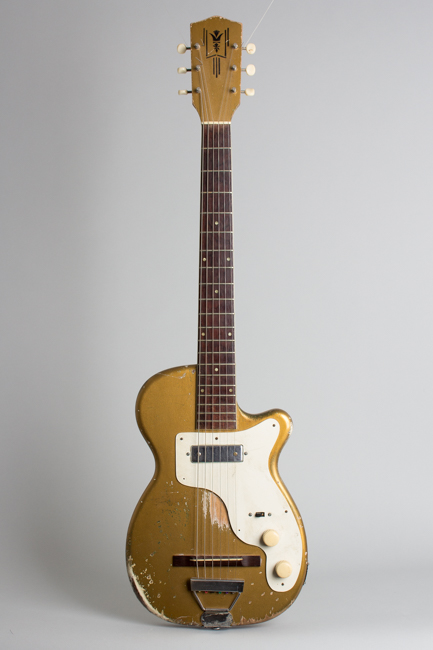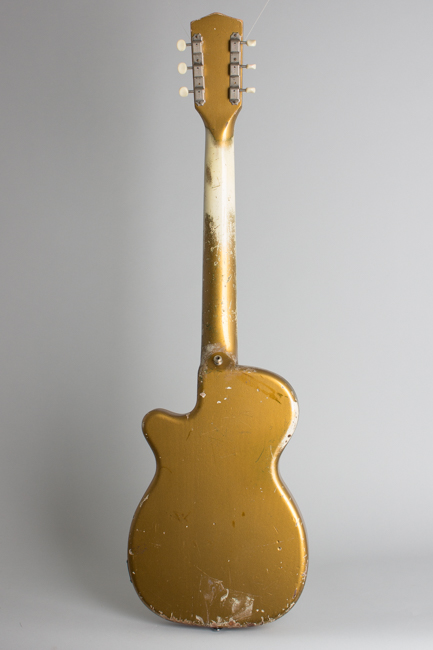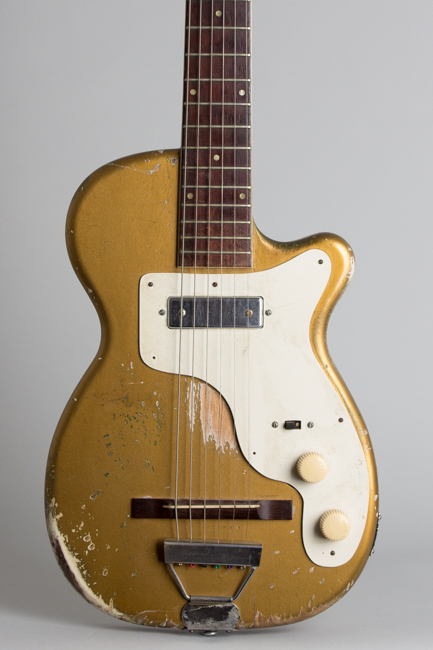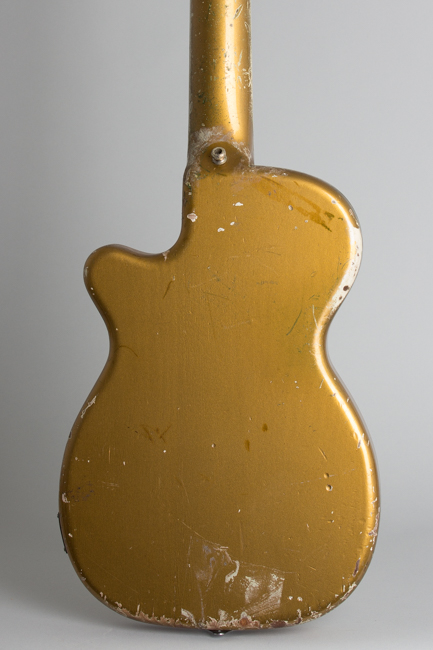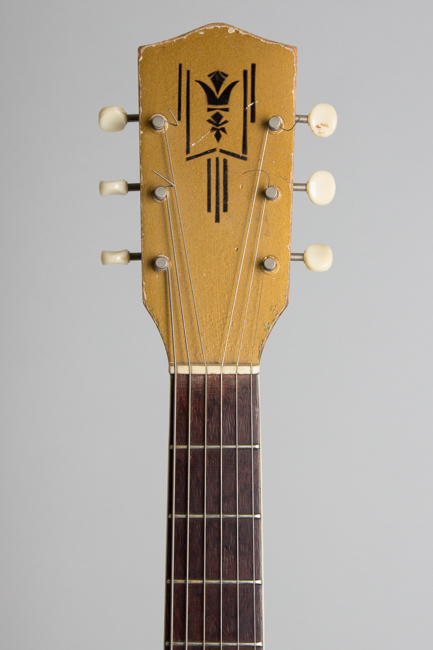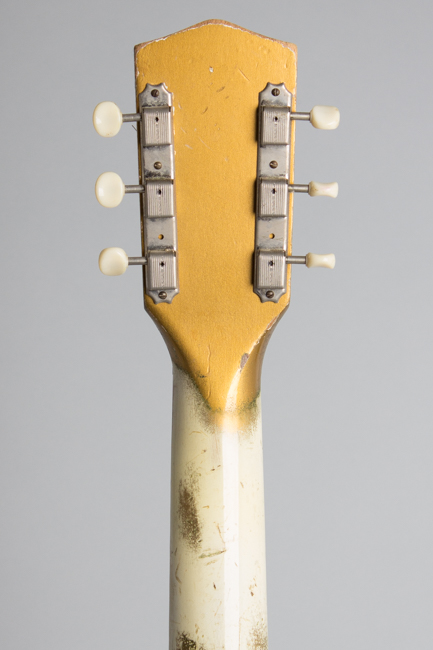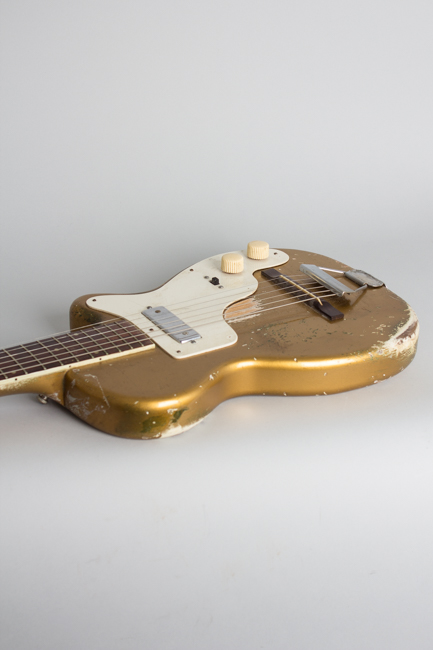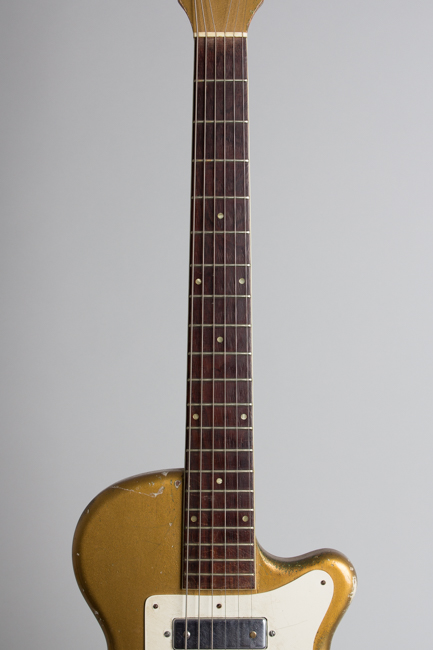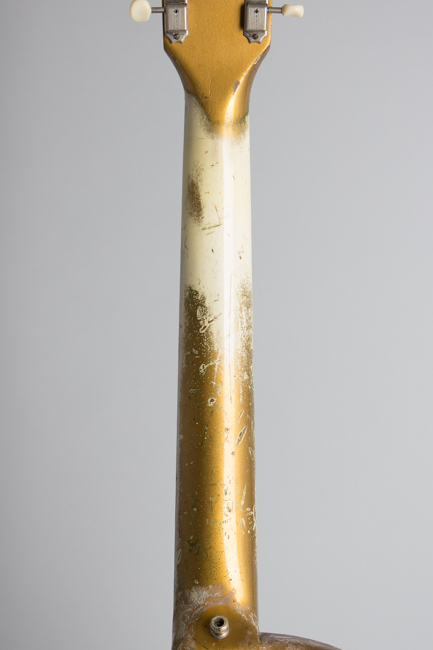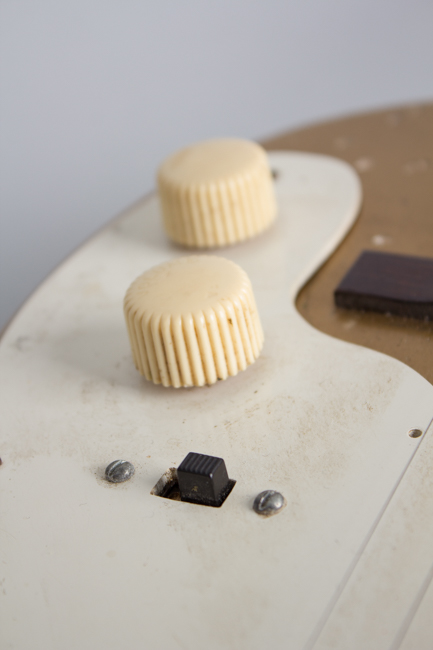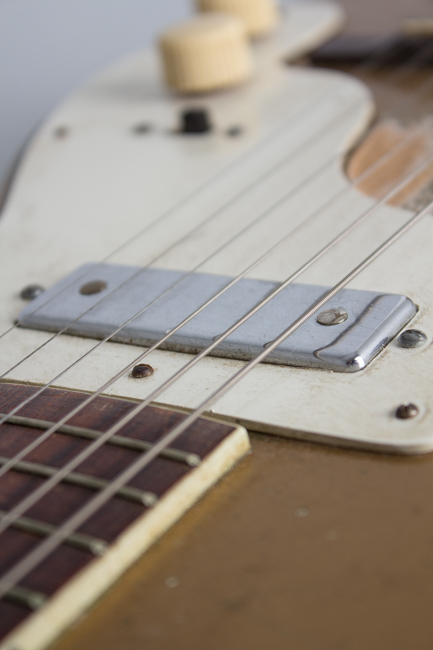Harmony H-44 Stratotone, previously owned by Marc Ribot Solid Body Electric Guitar , c. 1957
This item has been sold.
Item # 10339
Prices subject to change without notice.
Harmony H-44 Stratotone, previously owned by Marc Ribot Model Solid Body Electric Guitar, c. 1957, made in Chicago, gold lacquer finish, hardwood body and neck, rosewood fingerboard, black gig bag case.
This is one of the most well-known examples of Harmony's primal slab-O-wood solid body, the H-44 Stratotone, which after being forgotten for decades is now a much appreciated instrument. This particular guitar was a long-serving gigging and recording instrument for New York's protean guitar maven Mark Ribot. As such it is VERY well-used; We love Mark but he is not noted as being easy on his equipment! Still it remains in fine playing condition, exactly as last used by the man himself. Not coincidentally it is the best sounding one of these we have ever heard; it really rings acoustically in a way many do not and is quite a bear when plugged in!
The H-44 was Harmony's first solidbody electric, launched in 1953 as a response to Gibson's Les Paul. This one does not carry a brand name but the distinctive stenciled-on design headstock markings indicate was made for Alden's, one of Harmony's wholesale clients. The through-body neck is large and chunky, but the body fairly small making for a unique and very handy feel.
The small chrome covered single pickup was made by DeArmond and is justly revered for its powerful sound. The wiring is simple with single volume and tone knobs and a tone bypass switch. Despite its diminutive size the guitar is quite chunky sounding, particularly when pushed into overdrive situations. This model was discontinued by 1958; after decades of neglect the H-44 has become a very well-regarded instrument, thanks in no small part to Ribot's featuring of this very one.
It IS a great-sounding example; Mark told us years ago "Waits has the best one" but would not part with it, so this was the "next best" example Marc could find! This super cool, funky, and now much sought-after early solid body electric was the preferred personal instrument of one of the primary players who made them sought-after in the first place!
Overall length is 36 3/8 in. (92.4 cm.), 10 1/2 in. (26.7 cm.) wide at lower bout, and 1 3/4 in. (4.4 cm.) in depth, measured at side of rim. Scale length is 25 in. (635 mm.). Width of nut is 1 3/4 in. (44 mm.).
This guitar shows a LOT of wear from heavy use but remains in its original configuration showing some typical modifications to make it road worthy. The original gold lacquer finish has a LOT of wear practically everywhere. There are dings, dents and scrapes overall; conveniently these can be easily matched to photos of the instrument in Marc's hands. The face has a spot under the strings worn well down into the wood, and a good portion of the back of the neck is worn down to the cream undercoat. There are old marks from tape used to secure a strap at various times. Much of this wear is the result of Marc's long use of the instrument, and photos from different years document the gradual addition of scars as it served on different projects.
The DeArmond-made pickup is original but has been re-mounted to the pickguard with screws replacing the original rivets. The rest of the electronics including the switch, pots and jack have all been replaced with more modern components. A ground wire has been run to the tailpiece, something these guitars lacked from the factory. The rosewood bridge, bone saddle and tailpiece remain original; it looks like there is a bit of sandpaper or tape under each bridge end. The lower screw securing the tailpiece is missing, but the tailpiece is solidly mounted and not moving. A metal recessed-center jackplate has been added -- the fragile original plastic one is long gone. The tuners are Kluson Deluxe style reissues substituted for the original open-plate Waverlys. Two heavy-duty strap buttons have been added.
Amazingly enough the frets and nut are still original; there is some fret wear but nothing severe enough to impair playability. The neck is very chunky and has remained much straighter than on many of these; the action is relatively low and this is a very playable guitar. It has more acoustic "ring" than many of these and is indeed "A good one!" According to Marc this guitar served him well over the years but the time had come to trade it in on different tools for his ever-evolving musical life. This humble Harmony has had a LOT of world-class music played on it in Marc's hands, both solo and in collaboration with other artists. We have left it exactly as he brought it to us, including the strings and a certain amount of what we would describe as schmutz on the pickguard. It is housed in an oversize gig bag tagged "Ribot: Teisco SSL2 baritone" that it appears to have traveled in quite a bit. Overall Very Good + Condition.
This is one of the most well-known examples of Harmony's primal slab-O-wood solid body, the H-44 Stratotone, which after being forgotten for decades is now a much appreciated instrument. This particular guitar was a long-serving gigging and recording instrument for New York's protean guitar maven Mark Ribot. As such it is VERY well-used; We love Mark but he is not noted as being easy on his equipment! Still it remains in fine playing condition, exactly as last used by the man himself. Not coincidentally it is the best sounding one of these we have ever heard; it really rings acoustically in a way many do not and is quite a bear when plugged in!
The H-44 was Harmony's first solidbody electric, launched in 1953 as a response to Gibson's Les Paul. This one does not carry a brand name but the distinctive stenciled-on design headstock markings indicate was made for Alden's, one of Harmony's wholesale clients. The through-body neck is large and chunky, but the body fairly small making for a unique and very handy feel.
The small chrome covered single pickup was made by DeArmond and is justly revered for its powerful sound. The wiring is simple with single volume and tone knobs and a tone bypass switch. Despite its diminutive size the guitar is quite chunky sounding, particularly when pushed into overdrive situations. This model was discontinued by 1958; after decades of neglect the H-44 has become a very well-regarded instrument, thanks in no small part to Ribot's featuring of this very one.
It IS a great-sounding example; Mark told us years ago "Waits has the best one" but would not part with it, so this was the "next best" example Marc could find! This super cool, funky, and now much sought-after early solid body electric was the preferred personal instrument of one of the primary players who made them sought-after in the first place!
Overall length is 36 3/8 in. (92.4 cm.), 10 1/2 in. (26.7 cm.) wide at lower bout, and 1 3/4 in. (4.4 cm.) in depth, measured at side of rim. Scale length is 25 in. (635 mm.). Width of nut is 1 3/4 in. (44 mm.).
This guitar shows a LOT of wear from heavy use but remains in its original configuration showing some typical modifications to make it road worthy. The original gold lacquer finish has a LOT of wear practically everywhere. There are dings, dents and scrapes overall; conveniently these can be easily matched to photos of the instrument in Marc's hands. The face has a spot under the strings worn well down into the wood, and a good portion of the back of the neck is worn down to the cream undercoat. There are old marks from tape used to secure a strap at various times. Much of this wear is the result of Marc's long use of the instrument, and photos from different years document the gradual addition of scars as it served on different projects.
The DeArmond-made pickup is original but has been re-mounted to the pickguard with screws replacing the original rivets. The rest of the electronics including the switch, pots and jack have all been replaced with more modern components. A ground wire has been run to the tailpiece, something these guitars lacked from the factory. The rosewood bridge, bone saddle and tailpiece remain original; it looks like there is a bit of sandpaper or tape under each bridge end. The lower screw securing the tailpiece is missing, but the tailpiece is solidly mounted and not moving. A metal recessed-center jackplate has been added -- the fragile original plastic one is long gone. The tuners are Kluson Deluxe style reissues substituted for the original open-plate Waverlys. Two heavy-duty strap buttons have been added.
Amazingly enough the frets and nut are still original; there is some fret wear but nothing severe enough to impair playability. The neck is very chunky and has remained much straighter than on many of these; the action is relatively low and this is a very playable guitar. It has more acoustic "ring" than many of these and is indeed "A good one!" According to Marc this guitar served him well over the years but the time had come to trade it in on different tools for his ever-evolving musical life. This humble Harmony has had a LOT of world-class music played on it in Marc's hands, both solo and in collaboration with other artists. We have left it exactly as he brought it to us, including the strings and a certain amount of what we would describe as schmutz on the pickguard. It is housed in an oversize gig bag tagged "Ribot: Teisco SSL2 baritone" that it appears to have traveled in quite a bit. Overall Very Good + Condition.
